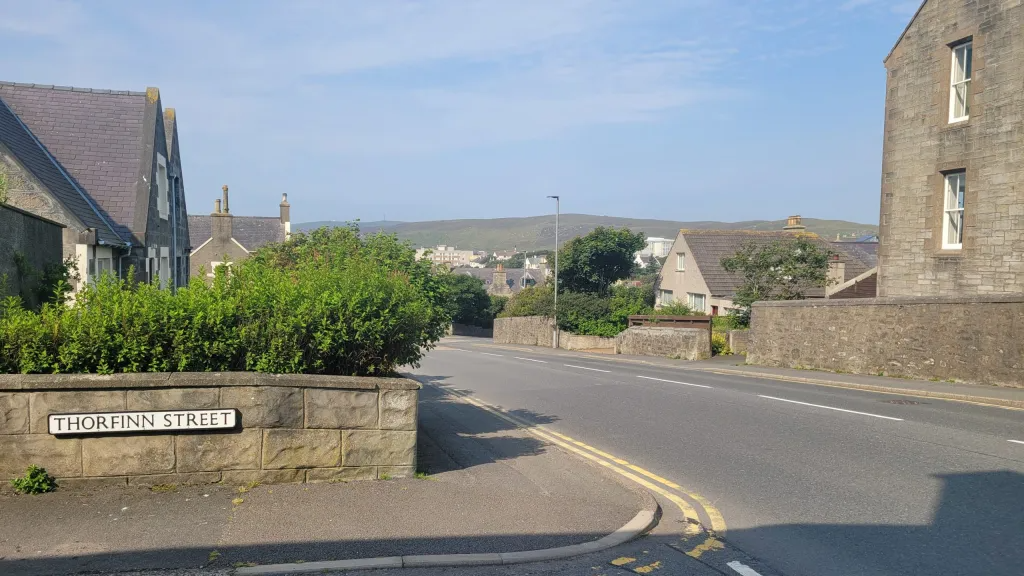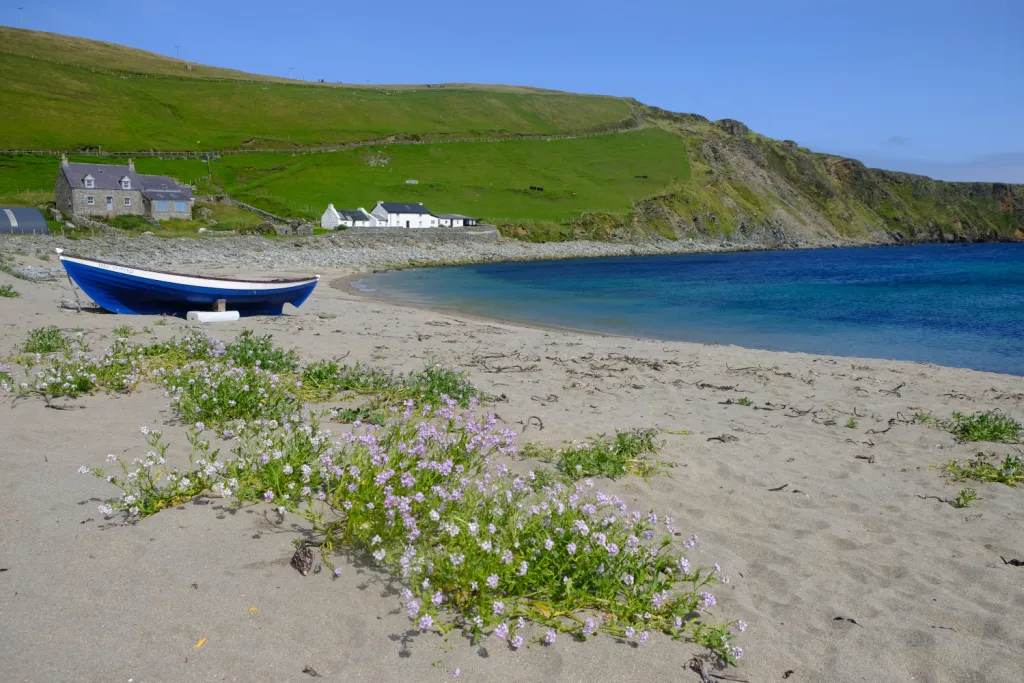Blog: Shetland races to build a sub-Arctic spaceport

On the United Kingdom’s northernmost island, the new space race is getting under way.
AAs part of my lifelong odyssey of cycling around aimlessly but always north, this summer, I decided to bike across Shetland, the United Kingdom’s northernmost stretch of territory. The trip would also get me closer to completing my two-wheeled and two-footed journey around the “Kingdom of the Isles,” as the Viking settlements that once stretched across the islands ringing Britain were known. In 2019, I biked across the Outer Hebrides and ran a marathon in Orkney. Now, I would cycle across the Norðr-eyjar, or northern islands.
While making my Shetland plans, when I went to book a hostel on Britain’s northernmost island, the accommodation’s Facebook page bore an unlikely message. Saxa Vord Resort was not open to guests. “The site and facilities are being used by the SaxaVord Spaceport as construction begins later this month,” the site announced.
It seemed fantastical: a spaceport? To be built on an island called Unst, home to all of 600 people and many more well-coiffed ungulates?
The off-Earth plans were fast taking shape, as I would find out after biking across nearly all of Shetland and back again – a journey of close to 300 kilometers in four days. After a night spent fitfully sleeping in the cinema of the overnight ferry from Orkney, I disembarked and met my host, an incredibly hospitable Lerwick native who immediately offered me tea and bacon rolls. A couple hours later, I proceeded to rent a wildly inappropriate pushbike in town, stuff way too many things into its panniers, and set off.

The irony is that I had planned Shetland as a stopover holiday between the United Kingdom and Scandinavia on my way to visit two actual space facilities in the Arctic: Andøya Space Center in north Norway and Esrange Space Centre in northern Sweden. Both facilities have existed for decades, and they are now competing to develop launch capacities for small satellites to attract the fast-growing commercial satellite industry. The Arctic is a key area of growth for the sector because from extreme latitudes, satellites can be easily launched into polar orbits. These hold the advantage of allowing nearly-global coverage, for every time a satellite crosses the North and South Poles, it circles a different line of longitude. Moreover, since satellites pass over the polar regions each time during their orbits, antennas are being erected at new ground stations below to downlink data frequently and efficiently.
In short, the Arctic holds an important key to Earth observation. Shetland, which I discovered while trying to book the Saxa Vord hostel-turned-spaceport, is trying to break into both the sector and the region. The company behind the push, SaxaVord Spaceport, seeks to build launch pads, a ground station, and a range of services in between in order to offer clients a full turnkey operation.
Unst: Britain’s northernmost inhabited island
At 60.74° N, Unst lies far north enough to be attractive to aerospace companies. It’s terra extremus for Britain and relatively far north even for Europe, Scandinavia aside. Lady Jane Franklin set foot on the island in 1845 when she was searching in desperation for her husband, Arctic explorer Sir Captain John Franklin, who perished in the Northwest Passage with his two vessels and most of his crew. Like its nearby neighbors of Iceland and the Faroe Islands, there are hardly any trees in Unst, let alone skyscrapers. The resulting unobstructed horizons are advantageous for satellite transmissions. Unst also was home to a Royal Air Force radar station, RAF Saxa Vord, between 1957 and 2006. This means some key infrastructure is already in place – and perhaps even more importantly, a local community supportive of aeronautical adventurism eager to see it return.
The northernness of Shetland, and Unst in particular, is inescapable. It is a matter of cultural and geographical fact rather than marketing spin. Shetland was under Viking influence followed by Norwegian rule from the 9th century until 1472, when the Crown of Scotland annexed the rugged islands. Local inhabitants continued to speak Norn, a West Nordic language, for several centuries thereafter. Today, you can barely go on a walk without tripping over a Viking Age settlement or burial mound. Streets bear names like “St Olafs Gate” and places names like “Tingwall,” from the Old Norse for Parliament, Ting. Shetland’s parliament was held in this area until the 1600s, whose windswept meadows resemble the more famous fields of Thingvellir in Iceland.
You can also hear the Norse influence in people’s melodic accents and in the stories they tell. More than anywhere else I’ve traveled in Scotland, I heard people say with a twinkle in their eyes, “You ken?” to mean “You know?”, and refer to children as bairn, resembling the Scandinavian equivalent, barn. People recounted regularly visiting the Faroes by boat whether for fishing or football tournaments. (That’s to say little of the former RAF employee I met who, upon returning from the Faroes to Lerwick, Shetland’s main town and port, failed to be awoken and ended up on a cruise around the Baltic Sea at no cost to himself. Since flying him back would have been costlier to the cruise company, he slept in the vessel’s only available room: the President’s Suite.) Shetland is an archipelago pounded by the North Atlantic, where the English Channel might as well be in another hemisphere. Don’t let the toasty cheese scones at the United Kingdom’s northernmost tea rooms fool you.

Among Unst’s septentrional superlatives will soon not only be the tea rooms, a house, and a bus station, but a spaceport. From the jaw-dropping white sand beach at Norwick, I walked up a steep former RAF road, which is now slipping off the side of the hill and not about to support trucks laden with satellites, no matter how small, anytime soon. From the top, I could see a long spit of flattened land protruding into the azure sea. The top is being excavated to ensure no Viking relics will get blown up by satellites blasting into space. That being said, perhaps the biggest misconception surrounding the spaceport is that the launches will be like Atlas or Saturn V rockets, or Elon Musk’s Falcon Heavies. “When people think of space, they think of SpaceX,” said one individual familiar with the space sector. “But that’s not the case.” These launches, 30 of which have been approved per year, will be smaller-scale since their payloads – small satellites, or “smallsats,” as they’re called – weigh under 500 kilograms.
Almost inevitably, the residents I spoke with believed that the idea of building a spaceport was “brilliant.” A gallery owner in Shetland said, “It’s the only industry nobody opposes. It doesn’t have any environmental impacts,” he indicated, comparing it to windmills, which many Shetlanders seem to oppose.
One former RAF employee I met near Skaw with his friends – and who I ended up joining on a long walk – thought the spaceport should have been built sooner. The listing of RAF Saxa Vord as a “scheduled monument of national importance” in 2012 had slowed things down. “If they were smart about it, they would have just bulldozed it into the sea,” he quipped in between drams of whiskey every kilometer. “Nobody wants to see anything there.”
His friends recounted how when the RAF base was operational, there used to be hundreds more people on the island and three schools as opposed to one. Maybe the spaceport would bring families back, even if not the same ones who had left. Testifying to the diversity that the military presence had brought, all four of the men had different accents. Some could trace back their family for generations in Shetland. Others were born to parents who had moved up from “the Mainland” to work for the base.
The only people annoyed by the local space race were those who’d come to the islands from the south to rest and retire. When I was examining the timetable at the bus stop for the hostel-turned-space port, an English woman walking her dog approached me.
“I don’t think those times are correct,” she offered. “Nobody uses this bus stop anymore.” I responded, “Lots of changes are happening here, with the spaceport and all, aren’t they?” “Unfortunately,” she grumbled, walking away, collie in tow. (He probably won’t like the loud noises of launches much, either.)
The new space race is taking place at the local level
With delays now behind SaxaVord Space Port, shovels are breaking ground in Unst. It is about time, for the era of “new space” – a period witnessing unprecedented privatization and commercialization – is well under way. Securing access to Arctic and sub-Arctic launchpads is crucial for the commercial firms from Glasgow to Seattle that are engineering hundreds of smallsats annually to create new constellations that will glitter and litter the sky above. For the many locations around the world’s northern latitudes that are competing to build space ports, it is a race to see who can get contracts signed first. It is municipalities that are competing head-to-head rather than nation-states.
Just as control of the Arctic was once thought to be fundamental to controlling the Earth’s atmosphere, now, it may be fundamental to controlling outer space.
Antarctica holds similar geographic promise, but for the moment, it is still far too remote. Before even reaching space, a satellite needs to be able to easily travel across the Earth to get to the launchpad. This is tricky enough on Unst. To reach the under-construction launch pads, a new road is being built through Haroldswick, the town in which the Saxa Vord facilities are located. The land was secured from crofters, who have relocated their sheep elsewhere – a task which is easier than if crops had to be moved.
SaxaVord Spaceport’s CEO, Frank Strang, has allegedly had dozens of failed business ventures. Yet somehow, the Scottish ex-RAF pilot has managed to convince investors that this one will be a success. It’s quite possibly the only spaceport in the world combined with a gin distillery, for when Strang purchased the site, the tipple factory came with the former military facilities. Now, when milestones are reached, SaxaVord employees toast with their own gin. As the site is not licensed, the pours flow freely.

SaxaVord’s first launch from the sub-Arctic island of Unst is scheduled for sometime later this year. Perhaps even more eagerly anticipated by local residents is the associated promise of faster internet. Even as satellites orbit overhead and transmit data by radio waves to antennas down below, to reach customers elsewhere on Earth, the data still must go by cable. The construction of ground stations usually drives the construction of new fiber optic cables, which would help speed up the internet on Unst. Anticipating a better-connected future, one local resident hoped, “When our friends elsewhere are talking about Netflix, then we’ll have seen the shows.”
For now, people still watch satellite television in Unst. One Sunday evening, in a house filled with people knocking back Chinese takeaway, cans of beer, and glasses of New Zealand wine (one man had moved away from Unst to become a dairy farmer, and was home visiting), the television was broadcasting a music-video countdown of the top 100 songs from the 1990s. Everyone was glued to the screen, wondering which track would be proclaimed the best if Nirvana’s “Smells Like Teen Spirit” was merely ranked second.

My new friends and I were so fixated that it turns out we missed the best sunset of the year, as I discovered at the post office the next morning. “My wife and I have a book of clouds, and we’ve never seen clouds like that before. We watched it for an hour and a half,” a little old man told the cashier. I felt momentarily crestfallen and then realized it was alright. On a little island where Vikings set ashore in longboats a thousand years ago, I had been watching rock’n’roll in technicolor beaming down from outer space. Somewhere out there, an orbiting ball of metal alerted Shetland that “Enter Sandman” was the 1990s’ top tune. And if all goes according to plan, perhaps soon, the islands will be associated not only with ponies and shelties, but satellites, too.
To the Arctic, Antarctic – and beyond
SaxaVord Spaceport doesn’t plan to stop in Unst. The company has its sights set on building ground stations across the polar regions in the Faroe Islands, East Greenland, Alaska, Finland, the Falklands, and Antarctica. As geopolitics would have it, however, the site that seemed most promising in the Faroes – a former NATO radar station – is now being reactivated. Whether the new race in the Arctic between the defense and commercial space sectors will result in conflict or cooperation within the military-industrial complex is anyone’s guess.
This post first appeared on Cryopolitics, an Arctic News and Analysis blog.
Related stories from around the North:
Canada: Microbe discovery in Arctic Canada could help better understand life on Mars, Eye on the Arctic
Finland: Finland needs its own space research centre, gov’t report says, Yle News
Norway: Scientists head to Svalbard to count animals for Walrus from Space project, Eye on the Arctic
Sweden: Sweden to launch satellites from space center inside the Arctic Circle, The Independent Barents Observer



